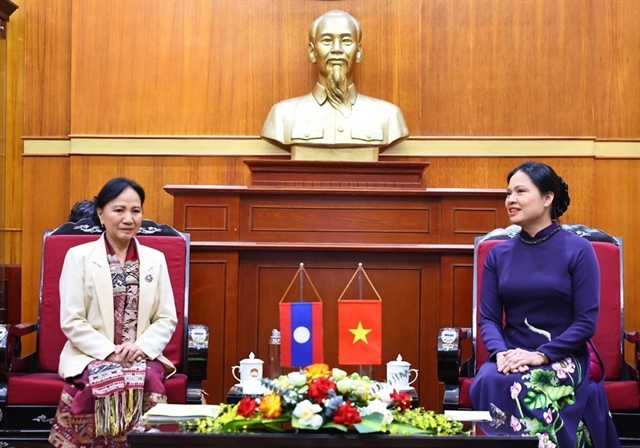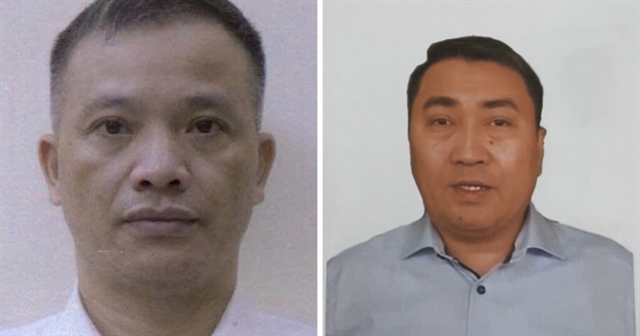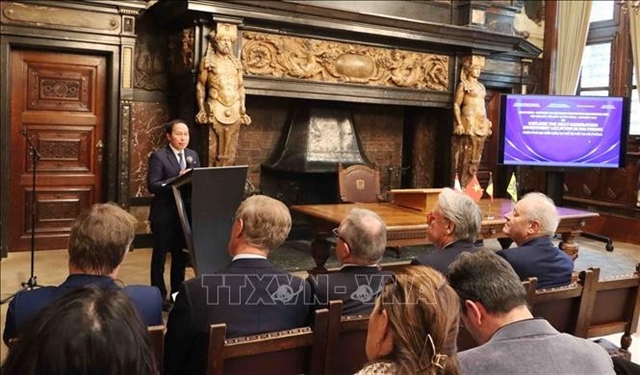 Business Beat
Business Beat

Despite solid results last year, VPBank announced a modest profit target for this year at its recent annual general meeting.
 |
The bank also announced plans to keep its bad debts ratio under 3 per cent though it was just 2.17 per cent last year. — Photo vnexpress.net |
by Thien Ly
Despite solid results last year, VPBank announced a modest profit target for this year at its recent annual general meeting -- 3.2 trillion (US$143.5 million) or a year-on-year increase of just VNĐ200 billion.
The bank also announced plans to keep its bad debts ratio under 3 per cent though it was just 2.17 per cent last year.
A bank spokesman considered the modest targets prudent, saying that with them the bank can carefully screen potential customers and improve its risk provisioning to cope with any volatility in the financial market.
Another lender, ACB, at its annual shareholders meeting, unveiled a profit target of 14 per cent higher than last year but bad debt target of less than 3 per cent though last year it was only 1.3 per cent.
Many other banks have also set the bar rather low for this year.
Three main factors are expected to affect the banking sector -- exchange rates, interest rates and especially bad debts.
On January 4, the State Bank of Việt Nam (SBV) began to apply a daily-adjusted "central rate" instead of maintaining a fixed reference rate for a long period of time.
The new system puts the onus on banks and other enterprises to remain on top of market developments to ensure they are not caught unawares by any changes in the exchange rate the SBV make.
At the beginning of the year deposit interest rates were increasing, but banks were not able to hike lending rates.
Meanwhile, the SBV requires banks to gradually increase provision for bad debts, which hits their profits. As Nam A Bank discovered. Its pre-tax profit last year before risk provisioning was pretty high, but its operating costs, mainly due to provisions for bad debt increased by 27 per cent to VNĐ588 billion, bringing down net profit to VNĐ194 billion, or a rise of just 3.7 per cent.
Sacombank reported losses of VNĐ583 billion in the fourth quarter of 2015 because its risk provisions increased six-fold from a year earlier after taking over a large amount of bad debts from SouthernBank, a lender it acquired.
As a result, its pre-tax profit of VNĐ2.14 trillion in the first nine months subsided to VNĐ1.01 trillion at the end of the year.
For this year the bank has set a pre-tax profit target of only VNĐ1.13 trillion since its risk provisioning is estimated at around VNĐ3.11 trillion.
In the fourth quarter of 2015 alone, Eximbank had to make provisions of VNĐ935 billion, which brought down its pre-tax profit to VNĐ89 billion.
The bank’s bad debt ratio reduced from 2.45 per cent in 2014 to 1.85 per cent last year after it sold a lot of the bad debts to the VAMC.
The bank has kept its profit target modest because of the vast amounts of bad debts it has sold and the provisioning it has to make for them.
Đầu Tư (Vietnam Investment Review) said last year banks had to make bad debt provisions of VNĐ75 trillion.
Banks’ modest profit targets this year indicate that risk provisions will continue to be a heavy burden for them.
The SBV has issued amendments to Circular 36/2014 allowing lenders to use only 40 per cent of their short-term deposits for medium- and long-term loans, down from 60 per cent.
Besides, the risk weightage for loans to the property sector increases from 150 per cent to 250 per cent.
But even before these changes have taken effect, banks have begun to fret about lending to the property sector, which is sure to be another blow to their profitability.
Catch-22 as PV Oil seeks foreign partners
Under Việt Nam Petrolimex Corporation’s restructuring plan, PetroVietnam Oil Corporation (PVOil) is scheduled to be equitised in the third quarter of this year.
The Government will retain 75 per cent and the remaining stake is sought to be sold, much of it to strategic foreign investors.
But at the moment it seems like an impossible task since foreigners cannot distribute oil products if they do not have ownership of a refinery.
There is only one operational refinery in Việt Nam, at Dung Quất, and it is owned by State giant PetroVietnam.
Interestingly, Russia’s Gazprom Neft recently called off negotiations to buy stakes in the US$3 billion Dung Quất refinery after it came to be known the latter will not continue to enjoy tax breaks after 2018.
A spokesman for the Ministry of Industry and Trade said Việt Nam was free to slap restrictions since distribution of petroleum products is not among the sectors the country committed to open up when it entered the World Trade Organisation a few years ago.
Another obstacle in identifying suitable foreign investors is that PVOil, like most companies in the hydrocarbons sector, is a giant, meaning the investors must have deep pockets and vast experience.
SBV moves to de-dollarise economy
On December 8 last year the SBV issued a circular on foreign currency loans prohibiting banks from lending to companies that do not make overseas payments.
This was targeted at firms that borrowed in foreign currency since interest rates are always lower on them than on đồng loans.
The central bank believes the time has come to stop the use of dollars in the economy.
The new policy took effect on April 1.
Most exporters said their costs would increase significantly since interest rates on dollar loans are only 3-3.5 per cent compared to at least 7.5 per cent on đồng loans.
Some banks have swiftly launched a new product: they lend in đồng but at dollar interest rates. In return, borrowers have to sell the dollars they receive from foreign customers at the exchange rate at the time of the loan.
This enables borrowers to reduce interest costs by half.
But the catch is in the fact they would lose out if the Vietnamese currency depreciates against the dollar after they borrow. — VNS




